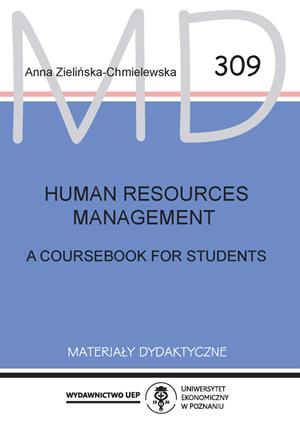
e-ISBN:
Edition: I
Publication date: 2016
First publication date: 2016
Pages: 90
Print: paperback
Electronic version:
Format: B5
License : commercial
last week: 12
last 3 months: 104
Anna Zielińska-Chmielewska
Human resources management. A coursebook for students
Availability and purchase
Zielińska-Chmielewska, A. (2016). Human resources management. A coursebook for students. Poznań University of Economics and Business Press.
The aim of this guidebook is to present the theoretical foundations of human resources management and use them in practice by means of exercises, tasks and case studies. The publication presents the processes of planning and organization of the work and profile of an ideal candidate, recruitment and selection processes, evaluation of candidates and employee motivation, training, salaries, determining possible career paths, and finally, leaving the job. Each of the issues is analyzed following a similar structure, i.e. embracing the essence of the problem, its components, their functions, implementation of the proposed tools. It is a versatile study – a must for students of all fields of studies, particularly economics, whether in full-time or extramural program. The guidebook is prepared for English-speaking students in the new field of study called Product and Process Management at
1.2. The nature of job position and job analysis
2.2. The nature of job position description
2.3. The nature of ideal candidate profile and recruitment requirements
2.4. Methods of describing jobs
2.5. Graphic presentation of an ideal candidate profile
2.6. Candidate questionnaire
2.7. The nature of employment planning
2.8. Employment planning methods
Chapter 3. Introduction to recruitment and selection process
3.1. The nature of employee recruitment
3.2. Types of recruitment
3.3. Selection of employees
3.4. Comparison of selection methods
3.5. Adapting a new employee, promotion, transfer and downgrading
3.6. Methods of conducting a job interview
Chapter 4. Introduction to candidate and employee assessment
4.1. Processing and using the collected information about candidates
4.2. Evaluation errors in the process of recruiting a candidate
4.3. “Whom to employ” decision
4.4. The nature of the employee assessment
4.5. The main objectives of the assessment
4.6. Evaluation methods
Chapter 5. Organizational culture
5.1. The definition of the organizational culture
5.2. The model of organizational culture by Edgar Schein
5.3. Functions of organizational culture
5.4. Types of organizational culture
5.5. Management grid and models as basic leadership theories
Chapter 6. Introduction to different motivation theories
6.1. Practical use of motivation theories in everyday life
Chapter 7. Career in a company
7.1. The definition of a career
7.2. Theories based on personality types – J. Holland’s hexagonal model
7.3. Theories based on career development – D. Super’s concept
7.4. Other ideas in career development theory
7.5. Organizational aspect of professional career – career management
7.6. Planning career development – career path
7.7. Career management instruments
7.8. SWOT analysis for the needs of human resources policy
7.9. Transition matrices
7.10. Biographical method
7.11. Career management – challenges and trends for the future
Chapter 8. Employee training system
8.1. The main elements of employee training system
8.2. Training plan
8.3. The elements of the training process by D. Kolb’s learning cycle
8.4. Training methods
8.5. Selected on-the-job training methods
8.6. Selected training methods outside workplace
8.7. Evaluation of the course and effects of training
Chapter 9. Introduction to remuneration system. Practical exercises
in creating and using remuneration system
9.1. The nature of remuneration
9.2. The elements of remuneration
9.3. The functions of remuneration
9.4. Types of remuneration
References


